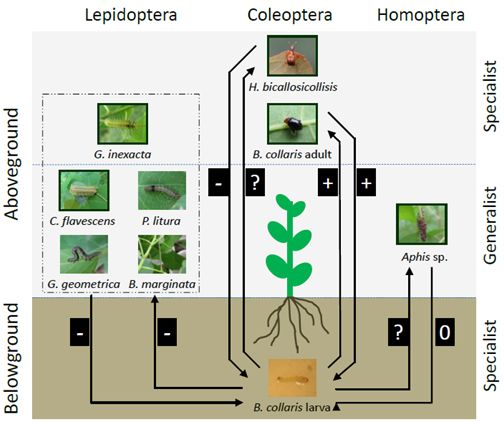Specific Plant Herbivore Interactions Determine Aboveground and Belowground Species Coexistence
2014-09-29
Aboveground and belowground herbivores can affect each other and shape community structure. Most studies have focus on interspecific aboveground and belowground herbivore interactions, while few study compares inter- and intraspecific aboveground and belowground herbivore interactions simultaneouely.
Previously, Dr. HUANG Wei, supervised by Prof. DING Jianqing from Wuhan Botanical Garden used Triadica sebifera as a study system to examine how plant mediate interactions between aboveground adults and belowground larvae of a specialist flea beetle, Bikasha collaris (Huang et al., 2012, Ecology) and to reveal the chemical mechanism which mediates interactions between aboveground and belowground herbivores (Huang et al., 2013, Proc R Soc B).
In this study, they extended the previous with the investigation of interactions between multiple heterospecific aboveground species and Bikasha collaris, which has both an aboveground adult and belowground larval life stage.
Conspecific aboveground adults affected belowground larvae positively, but heterospecific aboveground insects negatively affect belowground larvae. Belowground larvae increased conspecific adult feeding, whereas decreased heterospecific insect feeding and abundance. All these ecological effects as well as the variation in aboveground and belowground herbivore performances were consistent with changes in tannin concentrations in shoots and roots.
Results demonstrated that conspecific facilitation and heterospecific inhibition can co-occur between the aboveground and belowground compartments. It helped understanding how inter-and intraspecific aboveground and belowground herbivore interactions regulated population dynamics and community diversity.
These findings will deepen the understanding of the mechanisms that determine aboveground and belowground species coexistence and community assembly. It also has practical value for pest insect management and biological control of invasive plants.
Relevant results were published in Nature Communications entitled “Species-specific defence responses facilitate conspecifics and inhibit heterospecifics in above - belowground herbivore interactions”.

Interactions between intraspecific and interspecific aboveground and belowground herbivores (Image by Dr. HUANG Wei)